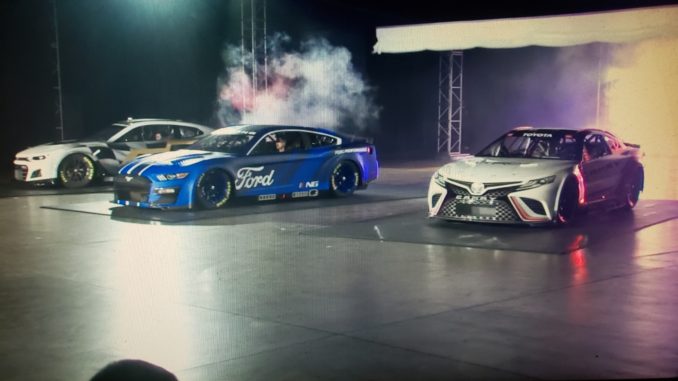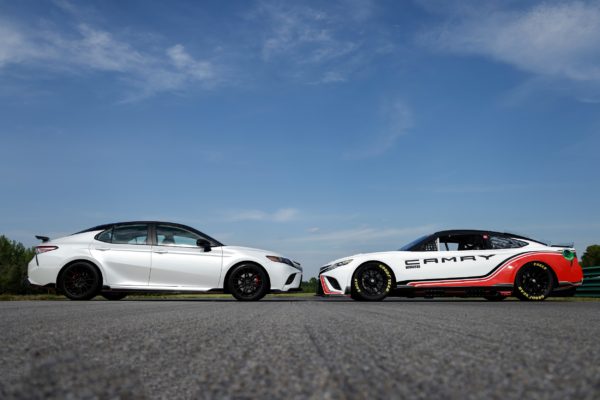
It took a little longer thanks to COVID, but NASCAR finally debuted its Next Gen cars to the world Wednesday at The Park Expo in Charlotte, North Carolina. The three OEMs showed off the models that will hit the track in anger starting with the 2022 Daytona 500.
What began as the “Gen-7” car in 2018 the model started out life on design boards with designers for Ford, Toyota, and Chevrolet and morphed into the Next Gen car which up until Wednesday had only been seen in testing with camouflaged or generic wrap designs.
Chevy will race the Camaro ZL1, Ford the Mustang, and Toyota the TRD Camry. All three cars are closer to mirroring their street counterpart than ever before. And that was exactly NASCAR’s intention.
“I think that at the highest level, one of the main goals is just that the sport remains healthy and strong, that it remains attractive to our current OEMs, teams and fans, but also attracts new ones,” said John Probst, NASCAR’s senior vice president of racing innovation. “As we kind of dive into that, it’s sort of your overarching goal. Then we know to be attractive to our OEMs, we need to be relevant to them.”
The new cars have bigger wheels, and more muscular coupe-style look, but also have an eye towards the future with the potential for hybrid power. On the competition side the new car designs will have more symmetrical car with features that decrease the dependence on aerodynamics and increase the emphasis on car setup in the hands of teams and drivers.
The new cars feature flange-fit bodies and that has reduced some of the negatives of full-contact racing in the Xfinity Series, a trait that’s expected to carry over with even stronger material for the Cup Series’ new model next season.
“When you look at the aspects of the car, particularly around the aerodynamics, reducing some of the downforce that’s out there, the cars will be harder to drive in the corners,” NASCAR chief racing development officer, Steve O’Donnell said. “The composite bodies; NASCAR is all about beating and banging on the racetrack. Less chance for that cut tire that you see under our current design.
“We’re really looking forward to our drivers going out there and showcasing their abilities. They’re the best in the world at doing what we do. We believe the car that our engineering team and the entire industry has put together is going to enable us to do that.
“Then you add the Goodyear tire, softer tire compounds, the look and the feel, a lot of race strategy and different options will play out at the racetrack. “
The timeline was delayed when the COVID-10 pandemic shut down the world and NASCAR.
“As hard as it was to make a decision to delay it a year because right now this car should be on — initially it was going to be on the racetrack at the Daytona 500 in 2021, but it was the right thing to do,” NASCAR president Steve Phelps said. “Obviously we couldn’t get parts. We didn’t know when we were going to be able to test, and so the timeline initially.
“Do I think we would have made it without COVID? I think the answer is yes. Has the extra time and development been helpful for us? I think so.
“So this has been a long time coming, but I think we needed to get this right. The cars obviously look fantastic, and the ability for us to create the testing time necessary, obviously to make sure we get the parts and pieces, get these cars developed, get them on the racetrack, get the deliveries to the teams obviously is very important for us to get right.”

Some highlights from the Next Gen car include:
- The symmetrical e body of the Next Gen car is designed to remove the skew and tail offset from the centerline that teams have used to create right-side sideforce. “Again, back to putting the car in the drivers’ hands,” Probst says. “Bigger tires, we’ll have more mechanical grip for them to lean on the tires vs. lean on the body, if you will, through aero.”
- The car will also be two inches higher off the ground, with a new splitter up front, a flat underbody and a rear diffuser that channels and transitions airflow moving under the car and reduces the effects of more disruptive “dirty” air behind it.
- In terms of safety, the redesigned chassis feature energy-absorbing foam bumpers in front and back. The reinforced tubing is rectangular, a shift from the current circular design. Roof flaps will carry over to the new-generation car, but it will also include a lower-mounted diffuser flap that deploys to help keep cars on the ground in the event of a backward slide at the series’ faster speedways.
- The Next Gen car will feature increased connectivity, with in-car cameras expected for every car in the Cup Series field. “Our goal is to have more cameras and more camera angles than ever, so that we can engage our fans and get them inside the car with their favorite driver,” Probst says. “We’re working out how to get more data out of the ECU (electronic control unit), getting more camera angles, higher-definition cameras, 360 cameras — you name it — so that when this thing goes live in 2022 that we’re bringing our fans something they haven’t seen before, from the car perspective but also from the broadcast perspective.”
- Officials anticipate having two rules packages with the Next Gen car — a low-downforce, low-drag, high-horsepower package for short tracks and road courses, and also a high-downforce, lower horsepower package for intermediate-sized tracks (1.5 miles) and longer. Target horsepower figures for the rules packages are still being determined.
- The Next Gen car features a new sequential five-speed shifter, which allows drivers to bump forward and back to change gears doing away with the traditional four-speed H-pattern. The new transaxle is expected to better accommodate the potential for a hybrid engine combination in later models, a timetable that remains uncertain for now.
- An independent rear suspension replaces the solid rear axle, and the Next Gen car will no longer have a track bar for adjustments. Teams will tune with five-way adjustable dampers and there will be a travel limiter to retain the higher ride height.
- The Next Gen car will move from a 15-inch wheel to an 18-inch diameter, and the material will be forged aluminum rather than the current steel. Tires will be wider, up from 10 inches to 12, with a smaller sidewall. Those new dimensions will emphasize mechanical grip with a larger contact patch, and Goodyear officials can build in softer tire compounds for increased grip and fall-off.
- Even with a single, center-locking lug nut instead of the current five-lug configuration, tests have shown a half-second is needed to fasten the larger single lug, compared to the 0.8-second speed that a capable tire changer needs to hit all five. No dramatic changes are expected when it comes to the essential choreography of a pit stop.
- Each of the three Next Gen models will have manufacturer-specific hood louvers, a release point for ducts that transfer air out of radiator. The system is intended to decouple engine performance from aero performance, offsetting the practice of teams taping off air intakes and placing undue pressure and heat strain on the car’s engine.
- With the lower roofline and the potential for a decrease in rear visibility, drivers will be able to see behind them with the aid of a rear-mounted camera.
- The Next Gen car will feature larger brakes with a better thermal capacity, rack-and-pinion steering and a 20-gallon fuel cell, up approximately two gallons from the current model.
Perhaps most importantly n going back to its roots the old adage of “win on Sunday, sell on Monday,” seems relevant again.
“When I look at this race car, it looks exactly like the race car that I can potentially buy on Monday,” Phelps said.”Obviously the win on Sunday portion is important, so getting in Victory Lane for these guys is important for Chevy, Toyota and Ford, but I think absolutely getting back to our roots, getting back to kind of putting the stock back in stock car will help sell vehicles on Monday. That’s certainly what our expectation is. I’m sure it’s the expectation of our OEM partners, as well.”

- Spire Motorsports confirms split with Corey LaJoie - July 25, 2024
- Kyle Larson wins NASCAR Brickyard 400 after overtime chaos - July 21, 2024
- Photos: NASCAR at the Brickyard Sunday July 21, 2024 - July 21, 2024
